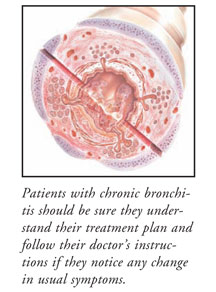
Obstructed Airways Make Breathing Difficult
Chronic bronchitis is a type of chronic obstructive pulmonary disease (COPD) caused by an inflammation of the bronchial tubes, the major airways into the lungs. Emphysema and asthma are other forms of COPD. All of these conditions result in obstructed or blocked airways, and make breathing difficult. Most patients who develop chronic bronchitis were exposed to air pollution in their home or workplace over a period of time. This air pollution could have come from cigarette smoke, chemical fumes, coal, metal, or grain dust, and other pollutants. The typical patient with chronic bronchitis begins to show symptoms of a slowly worsening chronic cough with white or colored sputum in their 40s or 50s. Many patients do not seek treatment at this stage, since they believe it is not a serious condition. In their 50s and 60s, these patients seek medical help because their shortness of breath begins to interfere with their life. A diagnosis of chronic bronchitis is made based on the patient’s history of symptoms, chest x-ray, and pulmonary function (breathing) tests. Often patients with chronic bronchitis have some emphysema or asthma along with their bronchitis. Since chronic bronchitis can cause permanent lung scarring, it is important that patients with symptoms see their doctor and begin a treatment program.
Treatment is aimed at preventing worsening of symptoms by avoiding smoking, pollution, and other triggers of symptoms, including infections. Proper nutrition and breathing exercises can also help the patient with chronic bronchitis lead an active, productive life.
An Inflammation of the Lining of the Lungs
More than 14 million adult Americans suffer from chronic bronchitis. Many more are in the process of developing the symptoms and are not yet diagnosed. In 1998, over 100,000 Americans died of chronic bronchitis and related lung diseases. The direct and indirect costs of obstructive lung diseases in the United States in the year 2000 were over 30 billion dollars.
Why Chronic Bronchitis May Develop:
Chronic bronchitis is an inflammation of the lining of the large airways in the lungs, usually caused by constant irritation. The source of this irritation is most often cigarette smoke, but chronic bronchitis can also develop when a patient is exposed to air pollutants such as chemical fumes or dust over a long period of time. The inflammation and swelling of the airways cause an increase in mucus production, leading to a productive cough with sputum. Chronic bronchitis is defined as the presence of a productive cough for three months of the year, two years in a row. In chronic bronchitis, air exchange is blocked by excess mucus and swelling of the lining of the airways. The wet cough in these patients is a result of this excess. Unfortunately, this mucus also provides an excellent environment for infection to develop. During these infections, the patient’s usually clear sputum often turns white, yellow, or green, and shortness of breath worsens. A history of the patient’s symptoms and a thorough physical exam are used in the diagnosis of chronic bronchitis. These patients may first notice an early morning cough, and eventually complain of a constant cough throughout the day. As the condition progresses, shortness of breath develops and the patient has decreased endurance with exercise. A chest x-ray helps to exclude other lung conditions with similar symptoms, such as lung cancer or tuberculosis. Breathing tests, also called pulmonary function tests, provide valuable information about the amount of inflammation, and whether there is any emphysema or asthma present. These tests also monitor the effectiveness of the drugs used to treat obstructive lung diseases and detect any worsening or improvement of the condition.
Treatment:
The first step in treatment is to avoid all lung irritants, including cigarette smoking and air pollution. The most important step for smokers with chronic bronchitis is to stop smoking. Exposure to workplace fumes or dust needs to be avoided. These measures will often greatly improve the symptoms. Patients with bronchitis are often advised to avoid using aerosol products and to wear a mask when in the presence of strong fumes. Since patients with any chronic lung disease are at high risk of complications from the flu, annual flu vaccinations are important. Pneumococcal vaccine is also used in patients with chronic bronchitis to prevent pneumococcal pneumonia. A good diet and a regular exercise program should be followed, since many patients need to improve their endurance. A respiratory therapist may use a pulmonary rehabilitation program to help strengthen the breathing muscles on a regular basis. Patients should pay special attention to an increase or decrease in sputum, a change in thickness or color of the sputum, swollen ankles, difficulty sleeping, excess tiredness, or increased shortness of breath.
Use of Bronchodilators:
Much of the lung damage from chronic bronchitis is permanent and cannot be reversed. However, patients often find some relief from bronchodilating drugs taken orally or inhaled into the lungs. These medicines open the air passages and make breathing easier. Bronchodilating drugs include metaproterenol, albuterol, terbutaline, pirbuterol, and theophylline. In some patients, oral or inhaled corticosteroids may help treat inflammation in the lungs. Antibiotics are often used when symptoms of an infection, such as increased cough, change in sputum, shortness of breath, and/or fever, begin. To prevent drying of mucus, patients should drink plenty of fluids. Your pharmacist can answer any questions about medications.






